Protect Nature
Protect Nature
At ADM, we have an unwavering commitment to global sustainability to create positive impact on the world and contribute to the greater good.
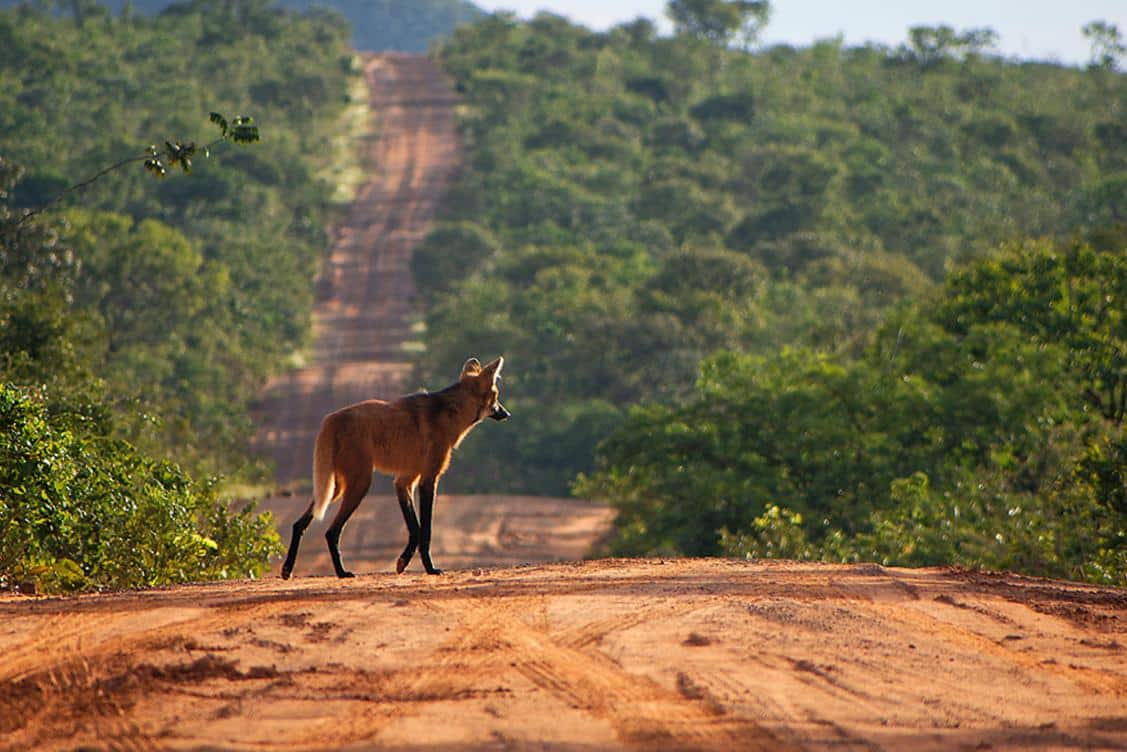
Key Topics
Goals and Key Performance Indicators
Strive 35
| KEY TOPIC | GOAL | PROGRESS | TARGET DATE | SDG ALIGNMENT |
|---|---|---|---|---|
GHG Emissions |
25% absolute reduction in Scope 1 + 2 GHG emissions over 2019 baseline by 2035 |  |
12/31/2035 | 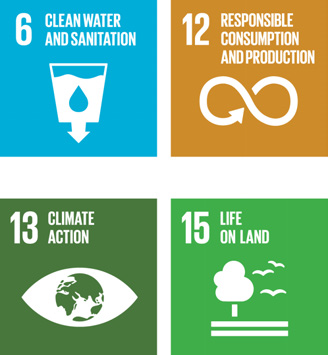 |
| 25% absolute reduction in Scope 3 GHG emissions over 2021 baseline by 2035 | 12/31/2035 | |||
Energy |
15% reduction in energy intensity over 2019 baseline by 2035 |  |
12/31/2035 | |
| Increase low-carbon energy usage to 25% of total energy use | 12/31/2035 | |||
Water |
10% reduction in water intensity over 2019 baseline by 2035 |  |
12/31/2035 | |
| 10% absolute reduction in water withdrawal over 2019 baseline by 2035 | 12/31/2035 | |||
Waste |
90% diverted from landfill |  |
12/31/2035 |
Biodiversity
| KEY TOPIC | GOAL | PROGRESS | TARGET DATE | SDG ALIGNMENT |
|---|---|---|---|---|
No-Deforestation |
100% deforestation-free across all supply chains | 12/31/2025 | 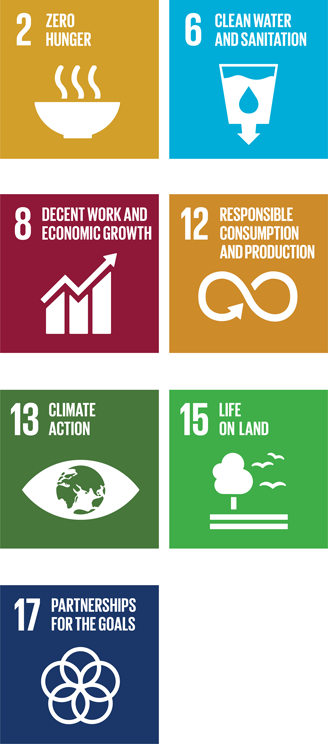 |
|
| 100% deforestation-free soy |  |
12/31/2025 | ||
| 100% deforestation-free palm |  |
12/31/2025 | ||
Traceability |
100% direct and indirect soybean suppliers in Argentina, Brazil, and Paraguay |  |
12/31/2022 | |
| Maintain at least 98% traceability to palm oil mill |  |
Ongoing | ||
| Increase traceability to palm plantation |  |
Ongoing | ||
Supplier Engagement |
100% of palm volumes sourced from direct suppliers who have a publicly available NDPE policy, implementation plan, grievance management system, grievance log, deforestation monitoring, and publicly report progress against their time-bound implementation plan. |  |
12/31/2022 | |
| 100% of palm oil volumes in the IRF “Delivering” category |  |
12/31/2025 | ||
| 100% of palm kernel oil volumes in the IRF “Delivering” category |  |
12/31/2025 | ||
Land Use Change |
Disclose emissions from land use change |  |
7/1/2024 | |
Land Conversion Risk Assessment |
Complete soy sector global assessment of the risk of conversion of natural ecosystems to soy production |  |
12/31/2023 | |
Regenerative Agriculture |
Enroll 4,000,000 acres in regenerative agriculture programs globally | 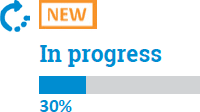 |
12/31/2025 | |
Tree Planting |
Engage with local organizations to plant native tree species | 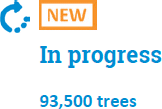 |
Ongoing | |
Reduction Targets |
Submit emissions reduction targets to SBTi or publish third-party validated LUC emissions reduction targets |  |
7/1/2024 | |
Biodiversity Mapping |
Develop a global biodiversity mapping strategy |  |
7/1/2024 | |
Priority Watersheds |
Develop a global water strategy focused on improving community well-being in priority watersheds, including water-stressed areas |  |
12/31/2025 |
Enrich Lives
| KEY TOPIC | GOAL | PROGRESS | TARGET DATE | SDG ALIGNMENT |
|---|---|---|---|---|
Workplace Safety |
50% reduction in Total Recordable Incident Rate (TRIR) from 2020 results |  |
12/31/2025 | 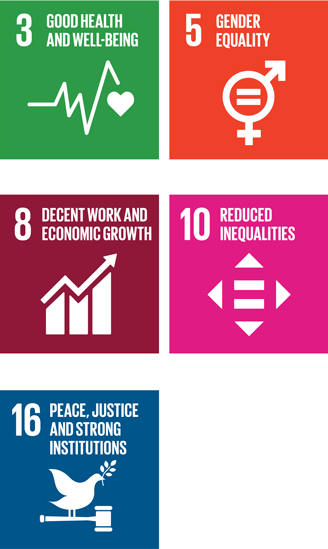 |
| 50% reduction in Lost Workday Incident Rate (LWIR) from 2020 results |  |
12/31/2025 | ||
Gender Parity |
Achieve 50% gender parity among ADM’s senior leadership structure |  |
12/31/2030 | |
Human Rights |
Assess and disclose salient human rights |  |
12/31/2023 | |
| 100% of palm volumes sourced from direct suppliers with a human rights policy that is fully aligned with ADM Human Rights Policy |  |
Ongoing | ||
| 100% of palm volumes sourced from direct suppliers conducting human rights due diligence |  |
Ongoing |

A critical part of environmental conservation, planting trees helps to rehabilitate degraded areas, create corridors to reconnect isolated pockets of forests, and support plant and animal biodiversity. Specifically, planting native saplings – trees that are a few years old and have already developed a root system – allows local biodiversity to recover by improving water quality, providing habitat for wildlife, preventing soil erosion, and sequestering CO2 from the atmosphere.
In 2022, our colleagues in Paraguay partnered with A Todo Pulmón to plant native tree saplings. Through an ADM Cares grant, the group was able to plant an additional 8,500 trees, bringing their annual total to 203,000.
In Brazil, we work with Parque Vida e Cerrado, a local NGO focusing on reforestation, scientific ideation, and environmental education. Their efforts have resulted in the planting of over 75,000 native seedlings, helping to restore natural corridors along streams and other degraded land within farms in our supply chain.
Check out a vídeo of our colleagues in action.
As part of the second phase of our efforts with Parque Vida e Cerrado, ADM Cares sponsored a study to monitor and track large animal movement through soybean farms in our supply chain to see the impact on apex species.
Two maned wolves were fitted with radio collars to observe their movement patterns. The red line shows the male wolf, and the yellow line shows the female.
In addition, trail cameras have been set up to monitor for other species. So far, the cameras have identified 31 different species of mammal, including five species listed as threatened by the IUCN: marsh deer, oncilla, giant anteater, South American tapir, and the Brazilian three-banded armadillo.

The American River Transportation Company (ARTCO), an ADM subsidiary, is helping support Living Lands & Waters’ (LL&W) efforts to protect, preserve, and restore the nation’s inland waterways by donating a used tugboat through ADM Cares.
The donation of a 750-horsepower vessel dubbed “Nancy S.” will serve as an upgrade to LL&W’s equipment and help the organization allocate funds to other projects that meet their mission. The LL&W crew spends up to nine months of the year living and traveling on their barge, hosting river cleanups, watershed conservation initiatives, workshops, tree plantings, and other impactful restoration work.
Our relationship with LL&W dates back to 2004 and throughout our partnership, ADM teams have volunteered their time to support programs including environmental restoration projects, invasive species removal, and free educational programming in communities along the Mississippi, Illinois, Tennessee, and Ohio Rivers. Through these efforts, we hope to strengthen and sustain these communities and support initiatives that drive meaningful social, economic, and environmental progress.
Land
Our global food system feeds 8 billion people, employs almost a third of the global workforce, and supports the livelihoods of more than 600 million farmers. As the global population has expanded, so too has agricultural production, with significant expansion in the past two decades making it possible for more people to have access to affordable and safe food.




However, this expansion came at the cost of natural ecosystems. Our sector is at high risk from the impacts of climate change, but it is also the largest emitting sector after energy, responsible for 23% of global greenhouse gas (GHG) emissions, with much of this resulting from the conversion of forests and other ecosystems to agricultural use. To keep the 1.5°C target in the Paris Agreement within reach, tackle food crisis risks, and enable the transformation to a global net-zero future, we must focus on limiting impacts from land use change, reducing emissions at the field level, leveraging the land’s ability to sequester carbon, and improving productivity of existing agricultural land.
No Deforestation
ADM has set a goal to be deforestation-free in all of our supply chains by 2025.
Improving traceability allows us to monitor our supply chain for deforestation.
In palm, we have consistently maintained high traceability to the mill level (over 98% for palm oil and palm kernel oil), and we are working with our direct suppliers to increase traceability to plantation of origin.
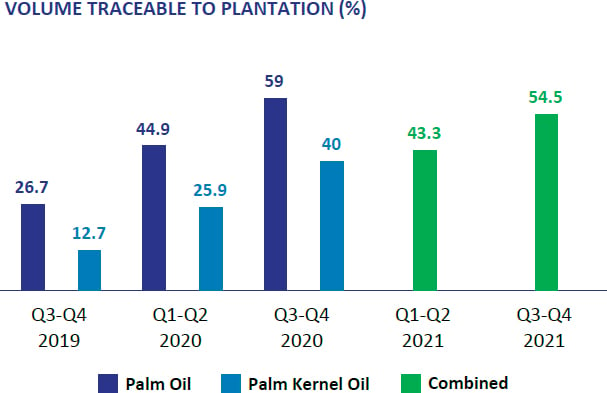
In 2021, we started reporting traceability for palm oil and palm kernel oil combined.
Moving forward, we are working with our direct suppliers to implement satellite monitoring in our palm supply chain. Additional information about our no-deforestation efforts in our palm supply chain can be found here.
For soy in South America, we achieved 100% traceability in 2022. We have mapped the field boundaries (polygons) of our direct suppliers to the farm. Indirect suppliers are traced to the first aggregation point. We then assess the location of the aggregation point for deforestation within a 50 km radius. Satellite monitoring of the polygons and engagement with growers in our supply chains enable identification of deforestation incidences as well as opportunities for reforestation efforts. Additional information about our no-deforestation efforts in our South American soy supply chains can be found here.
Using our map of direct suppliers’ farms and satellite imaging, we measured our deforestation-free volumes in Brazil and priority regions of the Cerrado at 99% using a 2015 baseline, the year we launched our No-Deforestation Policy. To increase transparency and credibility, the results were verified by a third party. By the end of 2023, we will complete this exercise for our indirect suppliers in Brazil and all suppliers in Argentina and Paraguay.
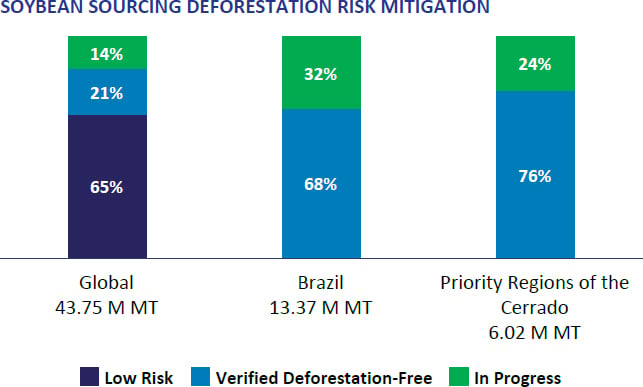
In the U.S., as part of our regenerative agriculture program, we map field boundaries of participating growers in our corn, soy, wheat, and peanut supply chains and use satellite monitoring to screen for deforestation. In 2022, our program engaged over 1 million acres. Using 2015 as a cut-off date to match our South America soy methodology and align with the publication of our policy, we identified 1,617 acres of deforestation in the seven year look-back period, with none of it occurring in the most recent year. This analysis shows our sourcing from these acres is 99.99% deforestation-free.
To meet our 2025 deforestation-free goal, we identified four key actions:
- Conduct a comprehensive deforestation risk assessment for all commodity and ingredient supply chains.
- For high-risk supply chains, identify direct and indirect volumes and determine a method for traceability.
- Develop monitoring protocols and supplier engagement plans to measure deforestation-free volumes.
- Engage a third party to verify results.
1.5° Roadmap
In 2022, ADM and 11 other agricultural trading and processing companies signed a joint statement at COP26 committing to “lay out a shared roadmap for enhanced supply chain action consistent with a 1.5 degrees Celsius pathway, that supports achievement of our goals, and increases collaboration and implementation in areas including: enabling policy environments, transparency on scope 3 emissions and indirect supply chains, and improving livelihoods for farmers.” Throughout the rest of the year, the Tropical Forest Alliance (TFA) and World Business Council for Sustainable Development (WBCSD), along with 14 of the world’s largest agricultural trading and processing companies, worked diligently to complete the Agriculture Sector Roadmap to 1.5°C.
We are working collaboratively to transform the agriculture sector. As a signatory of the Roadmap, we are developing company-specific implementation plans for our sourcing of palm oil and soy, which will include time-bound targets, a detailed scope, supply chain mapping and traceability, monitoring and response, and verification.
Specifically, the Roadmap requires disclosure of land use change emissions and submission of emissions reduction targets to the Science-based Targets initiative (SBTi) or another credible third-party for validation by July 1, 2024. Last year, ADM committed to submit targets to SBTi, and began the process of completing a full Scope 3 GHG emissions screening and inventory, including land use change, enabling our disclosure of land use change more than a year in advance of the deadline. Land use change emissions can be found in the Scope 3 section of this report.
Regenerative Agriculture
Regenerative agriculture is a system of farming that helps to rebuild the health of our soils while producing food to feed the world. The principles of regenerative agriculture system are based in Indigenous ways of land management and are adaptive to local physical conditions and culture and include:
- Maintaining living roots in soil
- Maximizing diversity – crops, soil, pollinators
- Minimizing soil disturbance
- Continuously covering soil
- Responsibly managing inputs – fertilizers, pesticides
For several years, ADM has partnered with farmers to implement sustainable and regenerative agriculture programs. These ranged from educational events to pay-for-practice to helping farmers achieve certifications and purchasing certified volumes. We gained valuable experience through these pilot projects, and in 2022, we launched our re:generations™ program with a goal of engaging over 1,000,000 acres in North America in regenerative agriculture projects, and exceeded that goal, engaging 1,900 farmers and 1.2 million acres in our inaugural year.
Our regenerative agriculture program works to identify and implement customized and targeted projects focusing on outreach, education, and continuous improvement to drive adoption of practices. We have identified five key advanced agricultural practices that have multiple positive outcomes such as reducing GHG emissions, improving soil health, and protecting water quality.
These practices include cover crops, reduced or no-tillage, nitrogen reduction and efficiency programs, integrated pest management, and diverse crop rotations.
Our program involves partnering with local conservation agronomy groups, including American Farmland Trust, Ducks Unlimited, Flint River Soil and Water Conservation Districts, Kansas Association of Conservation Districts, Minnesota Soil Health Coalition, and Practical Farmers of Iowa. These groups work with growers to select the practices that are fit for purpose for their specific farms, taking into account variances in soil types and weather. In addition to covering the cost of education and technical support, we also provide financial incentives to participating growers.
By partnering with Farmers Business Network (FBN) to expand availability of their Gradable platform to our network of farmers, we are able to collect and aggregate data with a focus on security and privacy while expediting calculation and analysis of results through a linkage to Field to Market’s Fieldprint Calculator.
Our customers are excited about this program, too. Last year, we entered into collaborations with several customers to increase the funding pool, allowing us to reach more farmers with the program. Leveraging Scope 3 inventory accounting principles, we allocate emissions, reductions, and removals to those customers, as well as use Field to Market metrics to measure additional impacts including biodiversity, water quality, soil conservation, irrigation water use efficiency, and land use efficiency. For example, ADM and PepsiCo signed a groundbreaking, 7.5 year agreement to support regenerative agriculture practices on up to 2 million acres of farmland.
In 2022, across 19 different projects we saw positive results in GHG metrics:
- Our regenerative agriculture acres emitted 253,000 MT less CO2e than the benchmark.
- According to the U.S. Department of Agriculture’s COMET-Planner, participating acres sequestered 115,500 MT of CO2.
When looking at individual projects, additional metrics provided valuable insight:
- Using the Field to Market Biodiversity Index – a metric designed to measure the capacity of a farm to support a diverse community of plants and animals – our corn project acres in Nebraska scored 86%, which is better than the local non-cover crop benchmark of 76%.
- Another project (multi-state and multi-crop) had a similar result with a Biodiversity Index score of 84%.
- A soy project in Iowa used the Iowa Soybean Association’s tile monitoring program to monitor Water Quality, which showed a 26% improvement through reduced nitrate pollution than fields without cover crops.
- Using the Illinois Nutrient Loss Reduction Strategy county-based load numbers, our Illinois project acres planting cover crops showed 20,200 lbs less nitrogen and 1,400 lbs less phosphorus run-off to waterways.
Encouraged by our learnings and success in North America, we have expanded the program to Europe and South America and set a goal to increase enrollment to 4,000,000 acres globally by 2025.
Moving forward, we are expanding our re:generations program to more strategically engage with growers on pesticide usage in their operations. We will collect data on pesticide usage and integrated pest management (IPM) practice implementation, as well as provide access to educational resources on IPM. This effort is expected to reach thousands of growers farming 3,000,000 acres in 2024.
Responsible Pesticide Management
In addition to our regenerative agriculture efforts, we also participate in several certification and rating programs, including ADM Responsible Soy, 2BSvs, Round Table for Responsible Soy (RTRS), International Sustainability and Carbon Certification (ISCC), Roundtable on Sustainable Palm Oil (RSPO), Sustainable Agriculture Initiative – Farm Sustainability Assessment (SAI-FSA), Red Tractor, Food Alliance, and Fair Trade. These programs allow us to provide certified products to our customers based on their goals and program focus areas.
We recognize that pesticide use in the agricultural sector has led to concerns regarding the potential for unintended environmental and health impacts. We also recognize that an estimated 45% of crop production worldwide is lost to pests annually. While we do not own farms and cannot mandate practices, we do strive to work with growers across our diverse global supply chains to support sustainable practices that substitute natural controls for some agrochemicals, foster ecosystem balance, reduce GHG emissions, and mitigate crop losses.
To that end, ADM aims to reduce the usage of chemical pesticides in our key agricultural supply chains by 2030. We will work to achieve this through the following activities:
- Engage 2,000 growers in 2024 to establish a baseline of pesticide usage in our key agricultural supply chains in key sourcing regions.
- Using established baseline, determine potential pesticide reduction opportunities and set a numeric reduction goal by the end of 2025.
- Provide educational resources and support on IPM to growers participating in our re:generations program.
- Increase sourcing of commodities through programs that have criteria to implement specific sustainable and regenerative practices, as listed below.
We engage with growers around the world on implementing sustainable and regenerative agricultural practices, including IPM and cover crops. IPM is designed to reduce risks to health and the environment through the design and implementation of a plan to prevent and manage pest damage by the most economical means with the least possible hazard to people, property, and the environment. Cover crops improve soil health, improving natural pest control mechanisms. Some species, such as cover rye, can even control some diseases.
We source commodities from several programs with components that specifically impact pesticide usage. Through Field to Market, we are incentivizing adoption of cover crops, in addition to other regenerative agriculture practices. The ADM Responsible Soy, Doing It Right, Food Alliance, ISCC, RSPO, and RTRS programs all require the development, implementation, and monitoring of IPM plans. Organic farming prohibits the use of synthetic pesticides.
In 2022, we sourced volumes from programs that specifically focus on pesticide management techniques and practices as follows:
| Metric Tons | |
|---|---|
| Wheat | 177,200 |
| Peanuts | 86,200 |
| Fruits, Flavors, Colors, etc. | 23,400 |
| Sunflower | 69,900 |
| Corn | 1,922,900 |
| Soybeans | 4,153,000 |
| Canola | 3,646,000 |
| Palm | 196,100 |
| Other Crops | 11,300 |
This represents approximately 8% of our raw commodity procurement.
Climate
Recently, the Intergovernmental Panel on Climate Change (IPCC) released their sixth synthesis report with straightforward statements and dire warnings. The evidence is clear: if we do not act now, the planet will experience irreversible and catastrophic changes to ecosystems around the world, jeopardizing the people and wildlife depending on them.




But there is also hope – promising low-carbon technologies, carbon removal through photosynthesis, ambitious national commitments, and support for community adaptations, as well as increased funding, can impact the degree to which the Earth experiences warming and climate change impacts.
Scope 1 + 2 Carbon Reduction
In 2022, ADM committed to working with the Science-based Targets Initiative (SBTi) to align our sustainability targets with ambitious goals to limit the average rise of global temperatures to 1.5 degrees Celsius. We also announced our aspiration to reach net-zero by 2050, and published a roadmap of current and future technologies that may help us to achieve our short-, medium-, and long-term carbon reduction targets.
Potential projects being evaluated include:
- Purchasing and developing renewable energy through renewable energy certificates, power purchase agreements, and ADM projects. An example is our first wind project, which is expected to be operational mid-2023, and should provide our Brazilian operations with renewable power and reduce our Scope 2 footprint by more than 19,000 metric tons of CO2e per year.
- Discontinuing coal usage at our Mankato, Minnesota; Lincoln, Nebraska; and Des Moines, Iowa oilseeds facilities, with an estimated reduction of around 180,000 metric tons of CO2e per year.
- Exploring innovative technologies for reducing point source GHG emissions at three of our largest cogeneration facilities, which could provide ADM a method to reduce Scope 1 and Scope 2 emissions by approximately 3,000,000 metric tons when fully implemented.
- Expanding our carbon capture and sequestration capabilities.
- Following development of technologies and infrastructure to support next generation thermal energy generation, including hydrogen, renewable natural gas, small modular reactors, and post-combustion carbon capture and sequestration.
While we continue to assess our pathway to achieve net zero, we’re diligently working to ensure we meet our Strive 35 targets. In 2022, 39 projects were completed that are expected to reduce our Scope 1 + 2 footprint by around 135,000 MT per year. Two examples of projects completed include:
- Combustion controls improvements in Cedar Rapids, Iowa expected to reduce CO2e by 62,000 MT per year.
- Reverse Steam Tube Germ Dryer Airflow in Decatur, Illinois expected to reduce CO2e by 45,000 MT per year.
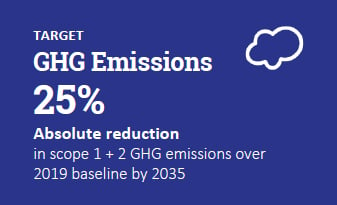
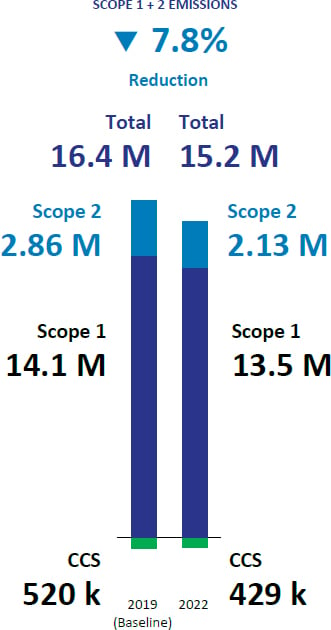
Scope 3
The past year saw the release of enhanced GHG accounting guidance, the most substantive for ADM being the GHG Protocol’s Land Sector and Removals Guidance. In accordance with these proposed best practices, we have recalculated our Scope 3 inventory and have incorporated the emissions associated with land use change. While this methodology change resulted in a higher emissions total for 2022 when compared to our previous disclosures, it paints a clearer picture and is aligned with global accounting protocols. It also allows us to meet the disclosure requirements of the 1.5°C Roadmap more than a year ahead of the target. We remain committed to and confident in achieving our Strive 35 reduction target.
When implemented across our sector, we believe this new guidance will provide stakeholders greater insight into the climate impact of agricultural supply chains and will demonstrate the carbon removal and sequestration potential of regenerative farming practices. Stakeholder collaboration is crucial when addressing Scope 3 emissions, especially as GHG accounting guidance continues to evolve. ADM is actively engaging NGOs, suppliers, customers, and third-party experts to continuously improve the accuracy and transparency of our Scope 3 inventory and uncover opportunities for emissions reductions.
As part of our commitment to pursue an SBTi approved target, we began evaluating and calculating all categories of Scope 3, and expect to have the full inventory complete in the second quarter of 2023. Last year, we established a new baseline using 2021 data because it was the most recent year and the highest quality of data available under the new GHG accounting protocols.
Also aligning with SBTi, we are disclosing our Scope 3 footprint in two pieces – FLAG and non-FLAG. Emissions from Forests, Land, and Agriculture (FLAG) are relevant to our sector and will require specific mitigation and sequestration activities that differ from other types of Scope 3 emissions.
Emissions from purchased goods and services make up the largest portion of our Scope 3 inventory. This category includes farm-level emissions from fertilizers, fuels, and other direct emissions sources, as well as emissions from land use change, which we currently calculate using statistical land use change (sLUC) methodology.
Our Scope 3 inventory currently includes categories 1-5 and 10: Purchased Goods and Services; Capital Goods; Fuel and Energy Related Activities; Upstream Transportation; Waste from Operations; and Processing of Sold Products.
As we work to reduce our Scope 3 footprint, key objectives include:
- Increasing traceability and satellite monitoring to calculate actual land use change emissions.
- Working with farmers in our supply chains to implement regenerative agriculture practices to reduce on-farm emissions and sequester carbon in the soil.
- Collaborating with transportation providers to reduce emissions through initiatives such as Sea Cargo Charter, Green Shipping Corridors, and increased biofuel usage.
- Engaging with downstream customers to gain insight to emissions from the processing of ADM ingredients into their products.
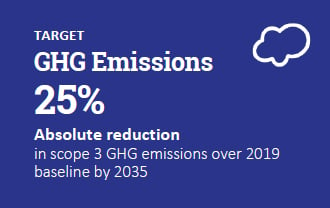
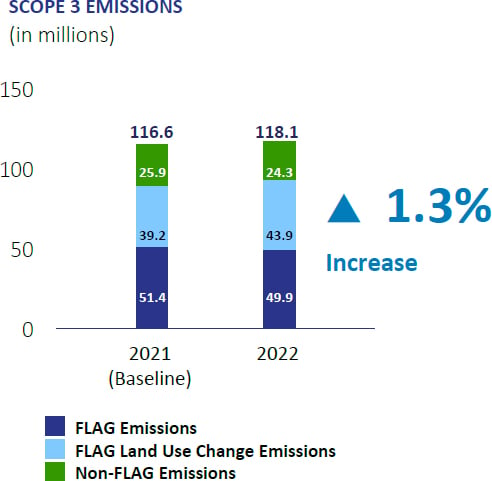
Energy
In 2020 when we announced our Strive 35 targets, we included a goal on energy intensity to ensure we continue to drive energy efficiency within our facilities as a way to support our GHG reduction goals. We have discovered that the diversity of our operations and energy portfolio across our global footprint does not allow for a meaningful roll-up of energy intensity on a per unit of production basis. The variation between a corn wet mill and an oilseeds processing facility is significant, and even the difference in energy needs between two different oilseeds can affect progress toward the goal. In addition, the lack of distinction between energy types (fossil, renewable, etc.) means that we lack insight into the true impact on the environment.
Taking this into consideration, we will continue to track energy intensity to drive efficiencies and will report our progress against our existing goal, and we are adding a new goal to increase the use of low-carbon energy sources. Because of our use of onsite cogeneration, our overall energy purchase is less than 10% of our total energy usage, so we have set a more ambitious goal that includes onsite energy generation, as well. After review and vetting by the Utilities Center of Excellence (CoE), Strive 35 committee, and Sustainability and Corporate Responsibility Committee of the Board, we have added a renewable energy use goal. By 2035, we will increase our usage of low-carbon energy to 25% of our total energy use.
Low-carbon energy includes renewable energy sources such as wind, hydro, and solar, as well as zero or extremely low emission energy sources such as biofuels, nuclear, natural gas with carbon capture and storage, and low-carbon hydrogen and ammonia.
To achieve the goal of 25% low-carbon energy, we will explore new and existing technologies, increase the use of biofuels in our mobile and stationary equipment, and increase our procurement of renewable energy purchases through renewable energy certificates (RECs) and power purchase agreements (PPAs).
In 2022, ADM implemented 64 projects with energy savings benefits that are estimated to save over 488,000 MWh.
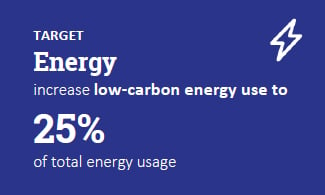

Innovation
Our eyes are always toward the future – to new ways, new formulas, and new possibilities. We’re at our best when we’re on the cusp. And we thrive as partners, co-creators, and instigators, using technical ingenuity to spark game-changing ideas and ground-breaking solutions. We have developed a broad portfolio of solutions in polymers, packaging, and home and personal care.
Plant-based Insulation Binding
The buildings where we live and work every day make up a large segment of GHG emissions. According to the International Energy Agency (IEA) September 2022 tracking report, these structures accounted for over 30% of global energy consumption in 2021. As the global population continues to grow, energy consumption in buildings continues to increase. As governments, companies, and people across the world work toward a 1.5°C future, improving the energy usage in buildings globally is critical to meet the goal.
One of the most impactful ways to improve building performance is by increasing insulation in both new and existing structures. The most common insulating materials today are mineral wool and fiberglass wool. Producers of insulating wool batts create thin fibers that are held together with a formulated binder. Historically, these binder systems used a petrochemical-based phenol-formaldehyde resin that was highly effective in bonding the fibers together. Many producers who are actively working to reduce formaldehyde in their insulation are discovering the power of biobased materials.
ADM has partnered with major insulation producers to implement new binder formulations derived from corn materials. These plant-based binders help provide the same insulating performance while eliminating the usage of formaldehyde resins.
This solution not only improves the health aspects of the insulation, but a key producer reported needing less energy to produce the binder.
LG Chem
ADM and LG Chem, a leading global diversified chemical company, launched two new joint ventures in 2022 that will leverage our fermentation expertise to meet the growing demand for lactic and polylactic acid (PLA). The two joint ventures, GreenWise Lactic and LG Chem Illinois Biochem, are slated to have production facilities built in Decatur, Illinois, with a projected annual capacity of 150,000 tons of high-purity corn-based lactic acid and 75,000 tons of PLA, respectively.
Lactic acid has applications across many industries, ranging from food and feed to cosmetics, and will also be used as a precursor for the production of PLA, a bioplastic. PLA is a proven solution that allows us to transform a renewable resource into an alternative to the petroleum-derived plastics dominating the market. Unlike typical plastics, the feedstock for PLA are crops that can be grown each year which also means that the bioplastic has the potential to be compostable under industrial conditions. This project follows the previous announcement of our companies’ collaboration, currently in the development stage, to use lactic acid to produce acrylic acid, another common component of consumer products that traditionally relies on petrochemical raw materials.
The announcement of these joint ventures marks another step forward in ADM’s partnership with LG Chem and further demonstrates how we see sustainability as both a key principle in how we operate as well as an opportunity for growth.
In 2021, we began the process of conducting a Scenario Analysis following the TCFD guidelines. The analysis looked at the potential impact of three warming scenarios: 1.5°C (latest recommendation from IPCC to prevent the worst effects of global warming), 2°C (aligned with the Paris Climate Accords), and 2.6°C (status quo). The first scenario assumes a rapid transition to a low carbon world in the next decade, limiting temperature increase to 1.5°C. This involves a high degree of transformation across the economy. Under this scenario, the worst anticipated physical impacts of climate change are avoided. The second scenario involves ambitious actions to mitigate climate change, limiting temperature increase to 2°C. This scenario requires greater policy action; however, there is still an increase in physical climate-related impacts. The third scenario is based on the current status quo with no changes to policies or actions and an anticipated increase in global temperature by 2.6°C resulting in increased physical impacts of climate change. ADM used these scenarios as written by the sources, except in the case of the third, status quo scenario, where transition risks were evaluated based on our existing Strive 35 commitments and implementation plan. In each of the scenarios, we identified potential sourcing shifts and limitations, operational changes, physical impacts, and opportunities. The primary risks identified fall into two categories: physical risks and transition risks. Key opportunities are related to products and services offerings.
Transition Risks
- Emerging regulation and carbon pricing mechanisms could result in increased operational costs in the short to medium term.
- Changes in policy or introduction of new policies could introduce additional tax requirements at our facilities. For example, in South America, introduction of the national legislation on biomass-based power generation units, which requires additional certification and taxes, could limit our ability to operate our assets and increase our operating costs.
- Market demand has a direct effect on production, as well as demand for certified sustainable commodities. Changes in consumer demand could result in additional cost of implementation that may not be overcome by product sales.
- ADM uses coal-fired cogeneration technology to meet a portion of its energy demand. We are working to reduce the carbon footprint of our operations, but transitions can be time intensive and costly.
Physical Risks
- Increased severity and frequency of extreme weather events such as cyclones and floods could lead to increased direct costs from the disruption of supply chains and impair our ability to deliver products to customers in a timely manner.
- Increased severity and frequency of extreme weather events such as cyclones and floods could lead to increased sourcing costs due to limited availability of agricultural commodities and impact ADM’s ability to produce goods, which would directly affect sales and revenue.
- Increased calls for preserving and enhancing biodiversity by taking acres out of production—at a time when the world’s supply of raw materials is in great demand—may challenge ADM’s sourcing of raw materials. As the global population grows, and producers in many areas of the world must plant more to feed more people, a balance must be appropriately struck, or raw material shortages may result.
Opportunities
- Developing enhanced transportation and warehousing scheduling, routing, and tracking technologies can reduce carbon footprint and costs while improving customer delivery satisfaction.
- Development and expansion of low-emission goods and services could lead to increased revenues resulting from increased demand. As various renewable fuel standards are implemented around the world, ADM has an opportunity to capitalize through the production and sale of ethanol, biodiesel, and renewable diesel.
- As demand for renewable products grows, development of new products or services from R&D and innovation could lead to increased revenues through access to new and emerging markets.
Freshwater
Water has become an increasingly scarce commodity in many regions of the world, and lack of water threatens to become one of the leading challenges we all face globally. Water is critical to biodiversity, healthy communities, and to our operations, and we must do our part to protect it, which is why ADM included a two-part water goal in its Strive 35 plan.
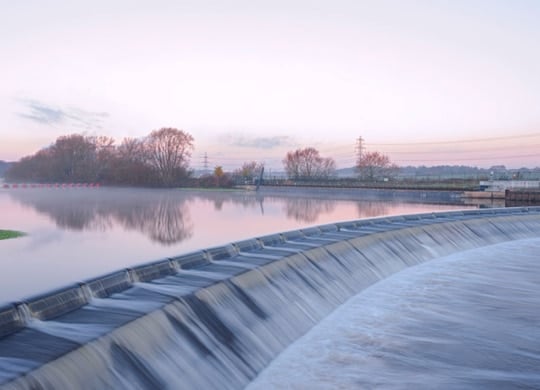



The first goal is designed to maximize water use efficiency and minimize water consumption across our global operations. The second goal is to develop a strategy to improve community well-being in priority watersheds, including water-stressed areas.
Operational Water Efficiency and Reduction
In 2022, although we continued our work to reduce our water intensity, we faced significant headwinds. Specifically, a promising new recapture technology that was scheduled to be piloted was put on hold due to supply chain interruptions. In addition, our production value, which we use as the normalizing factor in our intensity calculation, was down by 10% this year at our Major Water Users Group (MWUG) facilities. These two factors combined for a disappointing result in our 2022 water intensity number even though our water withdrawal was lower than the baseline. This discrepancy between absolute reductions and increased water intensity, as well as a lack of alignment with how we disclose our water data via CDP, led us to re-evaluate our water goal. After review and vetting by the Utilities Center of Excellence, Strive 35 committee, and Sustainability and Corporate Responsibility Committee of the Board, we have decided to refocus our water goal as an absolute reduction of water withdrawal. By 2035, we will reduce our absolute water consumption 10% over a 2019 baseline.
Water withdrawal consists of municipal water, surface water, well water, rain water, and wastewater purchased from third parties. For our reduction goal, focusing on reuse, recycle, and reclaim within our operations will allow us to make progress toward our goals and reduce our freshwater intake needs.
In 2022 we implemented several projects that resulted in reduced water withdrawal.
- In Decatur, Illinois, we implemented steam condensate system improvements expected to result in a water savings of nearly 180,000 m3, energy reduction of around 16,000 MWh, and operating cost savings of over $440,000 annually.
- At our biodiesel facility in Rondonópolis, Mato Grosso, Brazil, we focused on process optimization with a resulting water savings of around 40,000 m3.
- At our oilseeds facility in Spyck, Germany, we installed an additional gravel filter for our cooling water, which allows us to save approximately 138,000m3 of water per year.
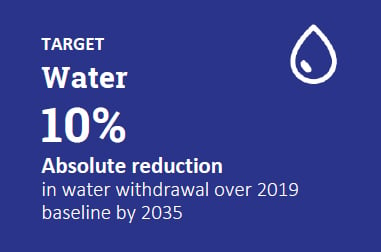

Water Replenishment
As part of our Strive 35 water goals, we committed to develop a global strategy focused on improving community well-being in priority watersheds, including water-stressed areas, by 2025. Over the past two years, with the support of a knowledgeable third party, we organized a broad group of internal stakeholders to work toward developing the strategic vision and framework for a Water Scarcity Program. The team includes representatives from sustainability, Utilities CoE, operations, and EH&S from North America, South America, Europe, and APAC. The overall strategic goals within the framework include:
- Maximize water use efficiency across global operations.
Practice the three Rs (reduce, reuse, and reclaim) at all of our facilities and consistently adopt the best management practices for minimizing use, maximizing returns, and maximizing the reuse potential of fresh water. - Track and report consumptive water loss.
Develop a consistent methodology for measuring water withdrawal and return and water lost through evaporation or into final products. Additionally, measure water-related risk at each of our facilities. - Establish community focused partnerships.
Develop relationships with partners performing water replenishment projects that benefit communities in the locations in which we operate. The use of community-based partnerships increases the local relevance of future projects while giving the community a voice in the decision-making process. - Develop a Global Water Replenishment Program.
Develop a global water replenishment program within the overall Water Scarcity Program to balance ADM’s consumptive water use with a portfolio of community-based water replenish projects implemented with partner organizations. - Integrate program into existing operations and processes.
Integrate the new water stewardship strategies into ADM’s existing operations to ensure the program’s efficiency, credibility, and longevity.
In the coming year, the team will work to define our water replenishment goal, lay out project requirements, prioritize implementation locations, and begin to identify projects and partnerships.
Learn more about our ESG approach
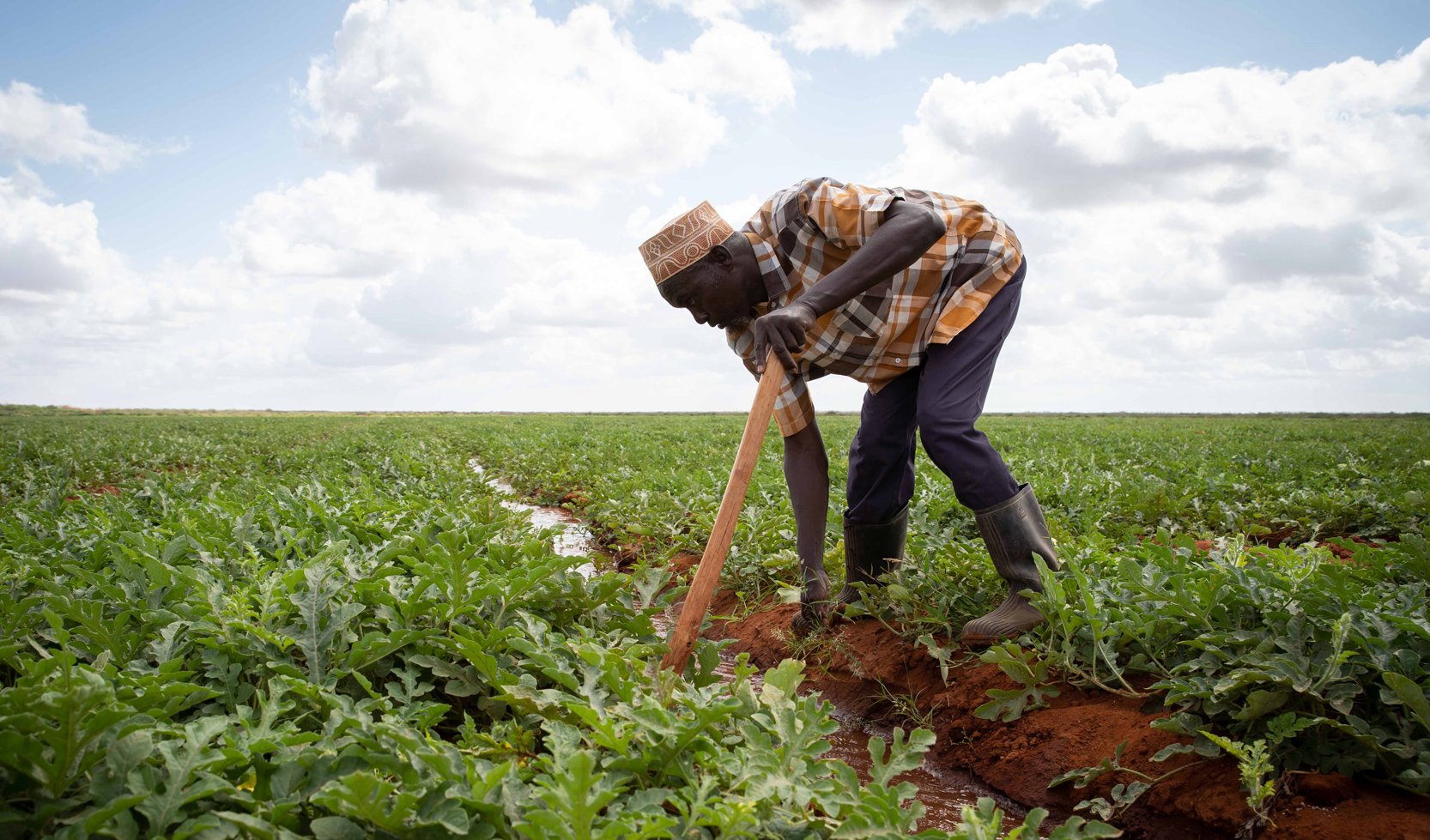
ADM is paving the way with good business practices, progressive solutions and mindful actions that make a positive impact.
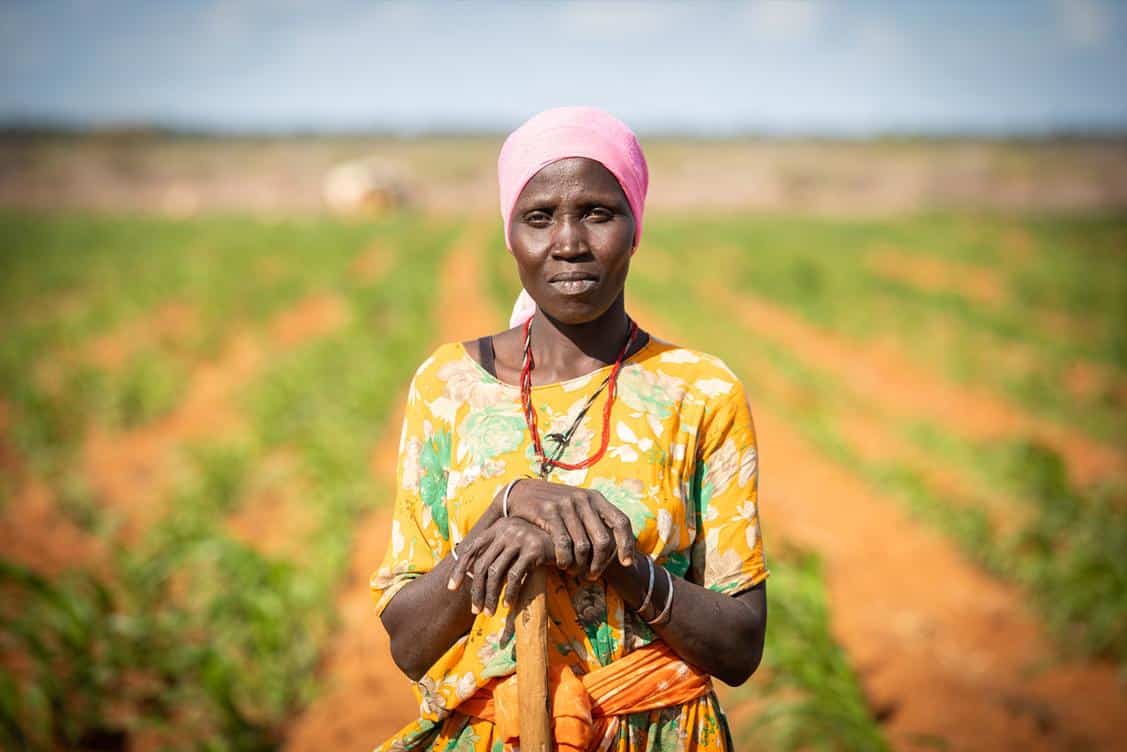
Food is fundamental. It sustains us, fulfills us and fuels our wellbeing. It’s the most basic need with the most critical impact. ADM is devoted to that impact every single day.

At ADM, we have an unwavering commitment to global sustainability to create positive impact on the world and contribute to the greater good.

We believe that a skilled workforce and strong relationships with communities are core to our success and growth, and we can make a lasting impact on the world.
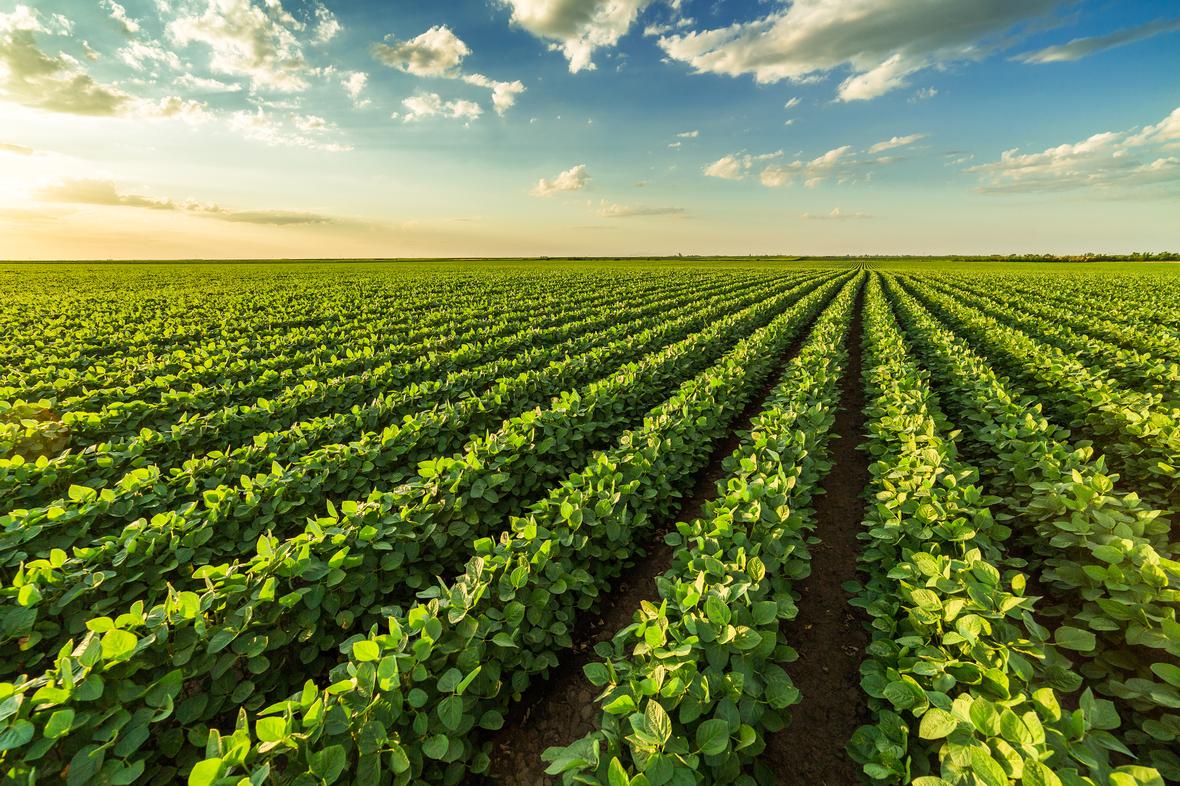
ADM has key social and environmental commitments and policies, and we regularly publish reports on our implementation progress.


